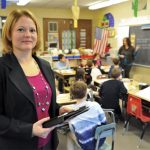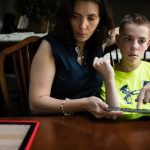A study co-authored by Neag School doctoral candidate, Robert Cotto, and former faculty member Sarah Woulfin, is featured. A survey of more than 150 parents whose children attend school in Hartford found that child care needs and concerns about the effectiveness of schools’ COVID-19 safety measures strongly impacted whether or not families sent their children back to school buildings for in-person learning in fall 2020.
Virtual classrooms may become a permanent fixture in the state of Connecticut. New legislation tasks the state’s Department of Education to develop plans for a K-12 statewide remote learning school that would use the same curriculum and have the same school year length as a traditional school, but would be under the jurisdiction of the State Board of Education.
“Teachers have new fluency and technology,” says Michael Young, who coordinated the educational technology program at UConn’s Neag School of Education. “Students have new fluency. Society and legislatures have a sense that this is doable now, because we did it for a year.”
With the pandemic projected to set women back a decade in the workplace, we take listener calls and talk with two working mothers about how their lives have been affected this past year. We’re joined by Quiana Agbai, a Boston parent, entrepreneur, and author of the blog and Instagram account “Harlem Love Birds,” and Jennie Weiner, a Somerville parent and associate professor of educational leadership at the University of Connecticut.
“I think it just revealed some of the deep inequities that have existed but didn’t really surface until it was forced to,” says Neag Professor of Educational Policy Casey Cobb. “So that was one of the main things that we’ve learned. I think a lot of schools adjusted very quickly and really made new efforts and creative efforts to keep contact with their families and their kids — with home visits in a safe manner and bringing food to families in need.”
Nearly a year since the nation went into lockdown due to the COVID-19 pandemic, just about everyone is struggling to maintain a semblance of normality. Parents of school-aged children have taken to social media and countless news stories have been written on the difficulties of balancing remote learning with remote working.
“So, the interventions are usually either small groups or either individualized really focused, targeted instruction for the student to sort of catch them up and get them up to kind of speed an up to the standards for that grade level and for that age range, rather than whole cloth, you know retention. Do the whole grade again,” said Sarah Woulfin, Associate Professor at UConn Neag School of Education.
Under the guidance of Mansfield teacher and Neag School alumna Madison Corlett, grade four students who are learning remotely this year have engaged in a series of “passion” projects, including the gift card fundraiser. With a goal to raise $5,000, this group of students, representing all three Mansfield elementary schools, launched a Go Fund Me page, setting a goal to help local businesses who they had heard were struggling as a result of COVID-19
Public school enrollment in New England is down during the pandemic. But even when kids are enrolled, it can be a struggle to get some to show up. This week on NEXT, how one district is tackling absenteeism and why doctors are increasingly concerned about youth mental health. Plus, Massachusetts school districts try to cope with a teacher shortage. And when a Vermonter’s business plummeted after COVID hit, she donned an inflatable T-Rex costume and started dancing.
Children don’t come with how-to manuals. Even if they did, they would all require a manual of their own, tailored to their unique make and model. That’s why caregiving can be rewarding, as well as puzzling and demanding – particularly for family caregivers of children with disabilities. Although these caregivers often report that the role gives them a sense of purpose, it usually comes with physical, emotional and financial strains. COVID-19 has added major hurdles to accessing, delivering and evaluating special education services.


